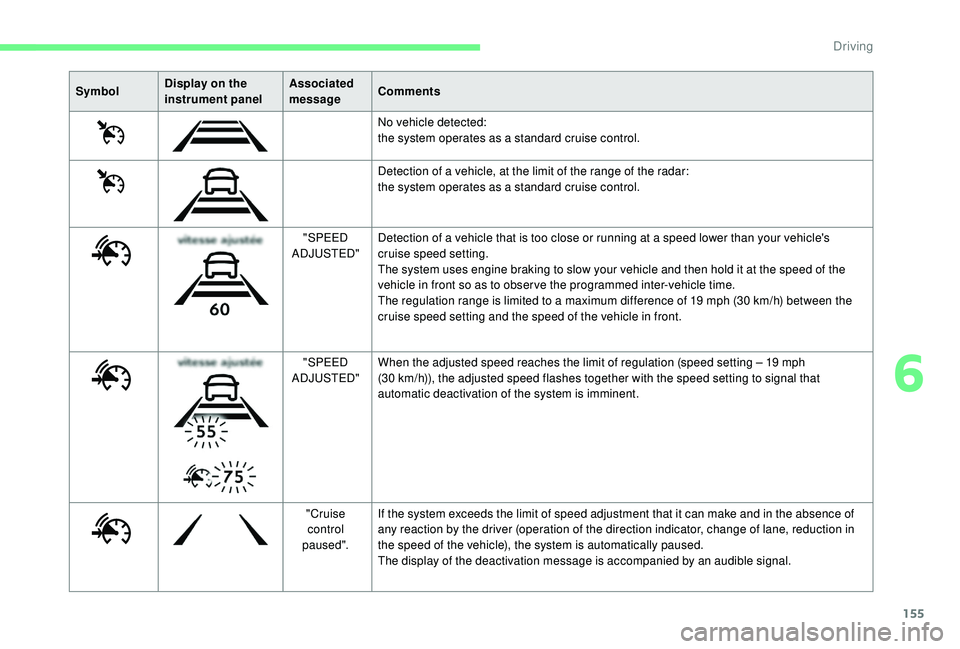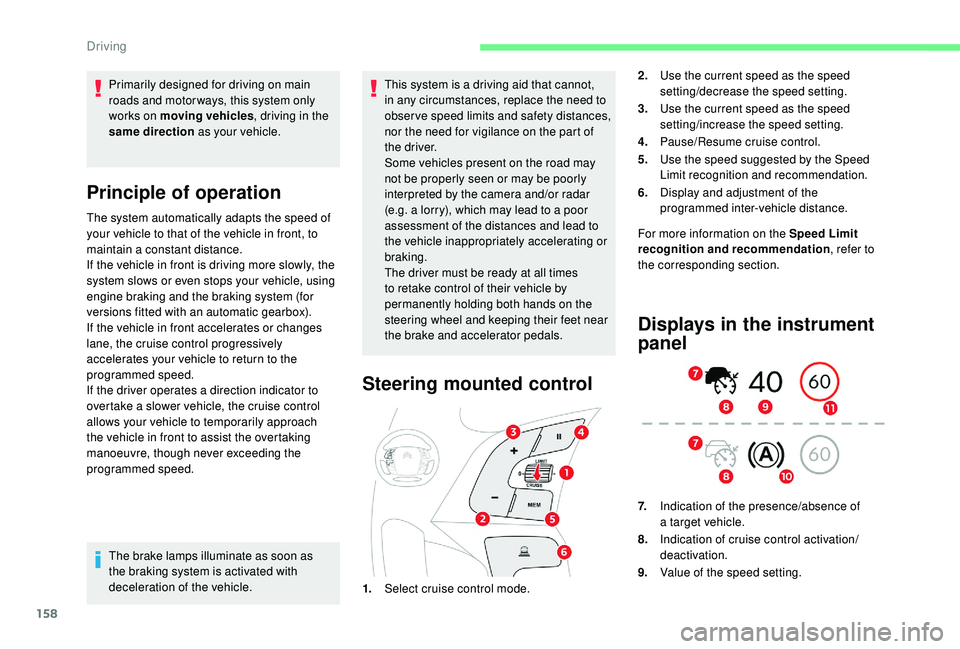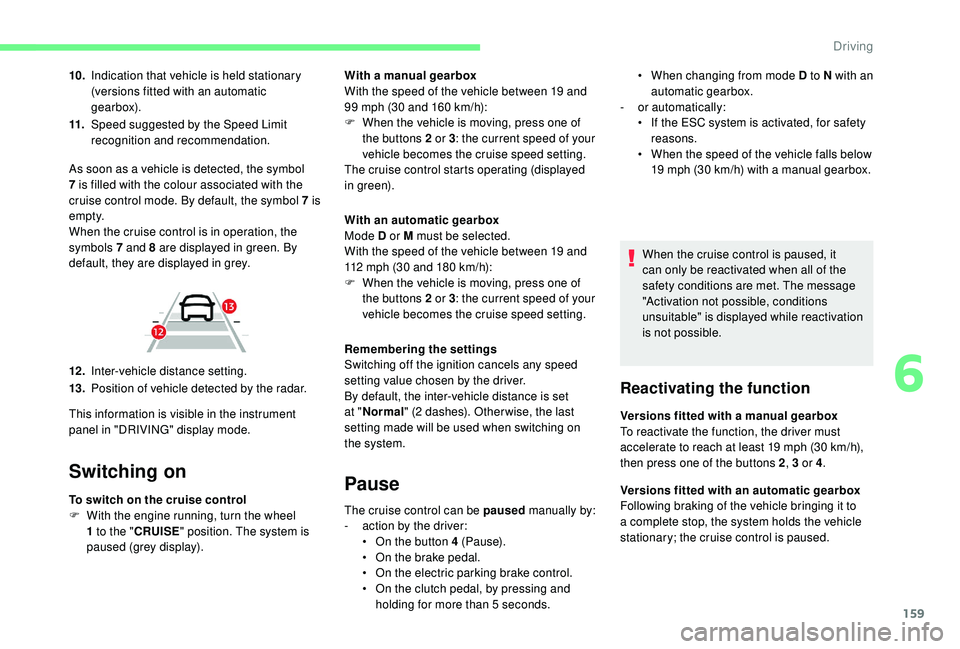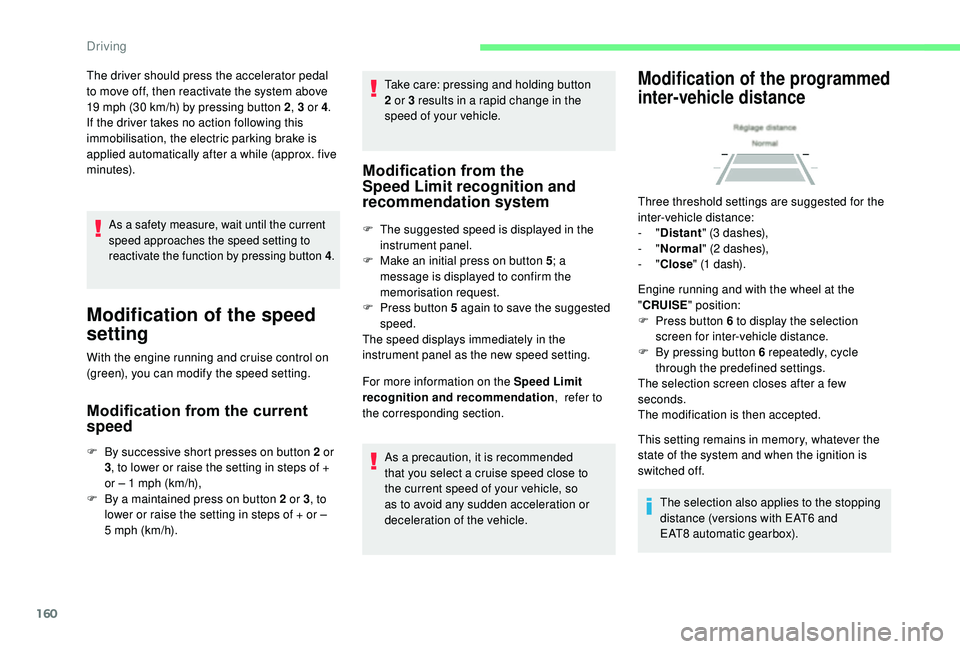engine CITROEN C4 SPACETOURER 2022 Repair Manual
[x] Cancel search | Manufacturer: CITROEN, Model Year: 2022, Model line: C4 SPACETOURER, Model: CITROEN C4 SPACETOURER 2022Pages: 316, PDF Size: 10.36 MB
Page 154 of 316

152
The adaptive cruise control uses only
engine braking to slow the vehicle.
Consequently the vehicle loses speed
slowly, as when releasing the accelerator
pedal.
The regulation range is limited: there will
no longer be any adjustment of speed if the
difference between the programmed speed
setting and the speed of the vehicle in front
becomes too high (19 mph (30 km/h)).
If the difference between the programmed
speed setting and the speed of the
vehicle in front is too great, the speed
cannot be adjusted: the cruise control is
automatically deactivated.
General information
The adaptive cruise control is switched on
manually, it requires the speed of the vehicle
to be between 25
mph (40 km/h) and 93 mph
(150
km/h) and the engagement of:
-
t
hird gear or higher with a manual gearbox,
-
s
econd gear in manual mode with an
automatic gearbox,
-
position D with an automatic gearbox. If the cruise speed setting is above
93
mph (150 km/h), the adaptive cruise
control switches to standard cruise control
mode, without automatic regulation of the
inter-vehicle safety distance (a message
appears in the instrument panel).
The adaptive cruise control cannot in any
circumstances replace the obser vation of
speed limits, nor the need for the vigilance
on the part of the driver.
It is recommended that you always keep
your feet close to the pedals.
The adaptive cruise control can be paused
manually or automatically:
-
b
y pressing button 4
,
-
b
y pressing the brake pedal,
- i f the ESC system is activated, for safety
reasons,
-
i
f there is an action on the electric parking
brake control,
-
w
hen an inter-vehicle time threshold is
reached (calculated according to the relative
speeds of your vehicle and the vehicle
in front and the inter-vehicle time setting
chosen),
-
w
hen the distance between your vehicle
and the one in front becomes too short, The inter-vehicle time setting is
memorised when switching off the ignition.
Steering mounted control
- when the speed of the vehicle in front is too
low,
-
w
hen the speed of your vehicle becomes
too low.
1. Select cruise control mode.
2. Use the current speed as the speed
setting/Lower the speed setting.
3. Use the current speed as the speed
setting/Raise the speed setting.
4. Pause/Resume cruise control.
Driving
Page 157 of 316

155
SymbolDisplay on the
instrument panel Associated
message
Comments
No vehicle detected:
the system operates as a
standard cruise control.
Detection of a
vehicle, at the limit of the range of the radar:
the system operates as a
standard cruise control.
"SPEED
ADJUSTED" Detection of a
vehicle that is too close or running at a speed lower than your vehicle's
cruise speed setting.
The system uses engine braking to slow your vehicle and then hold it at the speed of the
vehicle in front so as to obser ve the programmed inter-vehicle time.
The regulation range is limited to a
maximum difference of 19 mph (30 km/h) between the
cruise speed setting and the speed of the vehicle in front.
"SPEED
ADJUSTED" When the adjusted speed reaches the limit of regulation (speed setting – 19
mph
(30
km/h)), the adjusted speed flashes together with the speed setting to signal that
automatic deactivation of the system is imminent.
"Cruise control
paused". If the system exceeds the limit of speed adjustment that it can make and in the absence of
any reaction by the driver (operation of the direction indicator, change of lane, reduction in
the speed of the vehicle), the system is automatically paused.
The display of the deactivation message is accompanied by an audible signal.
6
Driving
Page 158 of 316

156
The adaptive cruise control uses only engine
braking to slow the vehicle. Consequently the
vehicle loses speed slowly, as when releasing
the accelerator pedal.
The system is paused automatically:
-
i
f the vehicle in front slows down too much
or too suddenly, and the driver does not
brake,
-
i
f a vehicle comes between your vehicle and
the vehicle in front.
The regulation range is limited to a maximum
d ifference of 19 mph (30 km/h) between the
cruise speed setting and the speed of the
vehicle in front. Above this, the system goes into
pause if the safety distance becomes too short.
Poor weather conditions (very heavy
rain, accumulation of snow in front of the
radar) may hinder the operation of the
system, with the display of the operating
fault message "SYSTEM INACTIVE:
Reduced visibility". The function remains
unavailable until the message disappears.
Since the radar detection range is relatively
narrow, it is possible that the system cannot
detect:
-
v
ehicles of reduced width, such as
motorcycles, for example, -
v
ehicles not running in the middle of the
lane,
When the adaptive cruise control is
automatically paused, it can only be
reactivated when safe conditions are
restored. The message "Activation
not possible, conditions unsuitable"
is displayed while reactivation is not
possible.
When the conditions allow, it is
recommended that the function be
reactivated by pressing button 2
or 3,
which will make the current speed of your
vehicle the new cruise speed setting,
rather than by pressing button 4 (on /
pause) which reactivates the cruise control
using the old cruise speed setting, which
may be very different from the current
speed of your vehicle.
Operating limits
- if the system does not slow the vehicle enough to continue to maintain a safe
distance, for example when descending
a
steep hill.
-
v
ehicles entering a
corner,
-
v
ehicles changing lane at the last moment.
The cruise control does not take account of:
-
s
tationary vehicles,
-
v
ehicles driving in the opposite direction.
Malfunction
In the event of a malfunction of the adaptive
c ruise control system, you are warned by an
audible signal and the display of the message
"Driving aid functions fault".
Have the system checked by a
CITROËN
dealer or a
qualified workshop.
Driving
Page 159 of 316

157
When the cruise control is working, take
care if keeping pressed one of the cruise
control programmed speed change
buttons: this can lead to a very rapid
change in the speed of your vehicle.
Do not use adaptive cruise control on
slippery sur faces or in heavy traffic.
When descending a
steep hill, the cruise
control system cannot prevent the vehicle
from exceeding the programmed speed.
On steep climbs or when towing, the
programmed speed may not be reached
or maintained.
The use of mats not approved by
CITROËN may inter fere with the operation
of the cruise control.
To avoid any risk of jamming of the pedals:
-
e
nsure that mats are secured correctly,
-
n
ever fit one mat on top of another. Operation of the radar, located in the
front bumper, may be impaired by the
accumulation of dirt (dust, mud, etc.) or in
certain weather conditions (snow, frost,
e t c .) .
The message "SYSTEM INACTIVE:
Reduced visibility". is displayed to indicate
that the function is in standby.
Clean the front bumper regularly.
If the front bumper is to be repainted or
retouched, contact a
CITROËN dealer
or a
qualified workshop. Certain types of
paint could inter fere with the operation of
the radar.
Adaptive cruise control
until vehicle is stopped/
until 19
mph (30 km/h)
Function until vehicle is stopped : with
automatic gearbox
Function until 19
mph (30 km/h): with manual
gearbox This system provides the following
functions:
-
A
utomatically maintains the
vehicle at the speed set by the
driver.
-
A
utomatic adjustment of the
distance between your vehicle
and the one in front.
Cruise control remains active after
changing gear regardless of the gearbox
type.
It manages the acceleration and deceleration
of the vehicle by automatically acting on the
engine and the braking system. With an automatic gearbox, automatic
adjustment of the distance can cause your
vehicle to come to a complete stop.
For this purpose there is a radar installed in the
front bumper.
6
Driving
Page 160 of 316

158
Primarily designed for driving on main
roads and motor ways, this system only
works on moving vehicles, driving in the
same direction as your vehicle.
Principle of operation
The system automatically adapts the speed of
your vehicle to that of the vehicle in front, to
maintain a
constant distance.
If the vehicle in front is driving more slowly, the
system slows or even stops your vehicle, using
engine braking and the braking system (for
versions fitted with an automatic gearbox).
If the vehicle in front accelerates or changes
lane, the cruise control progressively
accelerates your vehicle to return to the
programmed speed.
If the driver operates a
direction indicator to
overtake a
slower vehicle, the cruise control
allows your vehicle to temporarily approach
the vehicle in front to assist the overtaking
manoeuvre, though never exceeding the
programmed speed.
The brake lamps illuminate as soon as
the braking system is activated with
deceleration of the vehicle. This system is a
driving aid that cannot,
in any circumstances, replace the need to
obser ve speed limits and safety distances,
nor the need for vigilance on the part of
the driver.
Some vehicles present on the road may
not be properly seen or may be poorly
interpreted by the camera and/or radar
(e.g. a lorry), which may lead to a poor
assessment of the distances and lead to
the vehicle inappropriately accelerating or
braking.
The driver must be ready at all times
to retake control of their vehicle by
permanently holding both hands on the
steering wheel and keeping their feet near
the brake and accelerator pedals.
Steering mounted control
1. Select cruise control mode. 2.
Use the current speed as the speed
setting/decrease the speed setting.
3. Use the current speed as the speed
setting/increase the speed setting.
4. Pause/Resume cruise control.
5. Use the speed suggested by the Speed
Limit recognition and recommendation.
6. Display and adjustment of the
programmed inter-vehicle distance.
For more information on the Speed Limit
recognition and recommendation , refer to
the corresponding section.
Displays in the instrument
panel
7. Indication of the presence/absence of
a
target vehicle.
8. Indication of cruise control activation/
deactivation.
9. Value of the speed setting.
Driving
Page 161 of 316

159
10.Indication that vehicle is held stationary
(versions fitted with an automatic
gearbox).
11. Speed suggested by the Speed Limit
recognition and recommendation.
Switching on
To switch on the cruise control
F
W ith the engine running, turn the wheel
1
to the " CRUISE " position. The system is
paused (grey display). With a
manual gearbox
With the speed of the vehicle between 19 and
99 mph (30 and 160 km/h):
F
W
hen the vehicle is moving, press one of
the buttons 2 or 3
: the current speed of your
vehicle becomes the cruise speed setting.
The cruise control starts operating (displayed
in green).
With an automatic gearbox
Mode D or M must be selected.
With the speed of the vehicle between 19 and
112 mph (30 and 180 km/h):
Remembering the settings
Switching off the ignition cancels any speed
setting value chosen by the driver.
By default, the inter-vehicle distance is set
at " Normal " (2 dashes). Other wise, the last
setting made will be used when switching on
the system.Pause
• When changing from mode D to N with an automatic gearbox.
-
o
r automatically:
•
I
f the ESC system is activated, for safety
reasons.
•
W
hen the speed of the vehicle falls below
19
mph (30 km/h) with a manual gearbox.
When the cruise control is paused, it
can only be reactivated when all of the
safety conditions are met. The message
"Activation not possible, conditions
unsuitable" is displayed while reactivation
is not possible.
As soon as a
vehicle is detected, the symbol
7
is filled with the colour associated with the
cruise control mode. By default, the symbol 7
is
e m pt y.
When the cruise control is in operation, the
symbols 7
and 8
are displayed in green. By
default, they are displayed in grey.
Reactivating the function
Versions fitted with a manual gearbox
To reactivate the function, the driver must
accelerate to reach at least 19
mph (30 km/h),
then press one of the buttons 2 , 3
or 4.
Versions fitted with an automatic gearbox
Following braking of the vehicle bringing it to
a
complete stop, the system holds the vehicle
stationary; the cruise control is paused.
12 .
Inter-vehicle distance setting.
13. Position of vehicle detected by the radar.
This information is visible in the instrument
panel in "DRIVING" display mode. F
W
hen the vehicle is moving, press one of
the buttons 2
or 3
: the current speed of your
vehicle becomes the cruise speed setting.
The cruise control can be paused manually by:
-
a
ction by the driver:
•
O
n the button 4 (Pause).
•
O
n the brake pedal.
•
O
n the electric parking brake control.
•
O
n the clutch pedal, by pressing and
holding for more than 5
seconds.
6
Driving
Page 162 of 316

160
As a safety measure, wait until the current
s peed approaches the speed setting to
reactivate the function by pressing button 4 .
Modification of the speed
setting
With the engine running and cruise control on
(green), you can modify the speed setting.
Modification from the current
speed
F By successive short presses on button 2 or
3 , to lower or raise the setting in steps of +
or – 1
mph (km/h),
F
B
y a maintained press on button 2 or 3, to
lower or raise the setting in steps of + or –
5
mph (km/h). Take care: pressing and holding button
2
or 3 results in a rapid change in the
speed of your vehicle.
Modification from the
Speed Limit recognition and
recommendation system
F The suggested speed is displayed in the instrument panel.
F
M
ake an initial press on button 5 ; a
message is displayed to confirm the
memorisation request.
F
P
ress button 5 again to save the suggested
speed.
The speed displays immediately in the
instrument panel as the new speed setting.
For more information on the Speed Limit
recognition and recommendation , refer to
the corresponding section.
The driver should press the accelerator pedal
to move off, then reactivate the system above
19
mph (30
km/h) by pressing button 2
, 3
or 4
.
If the driver takes no action following this
immobilisation, the electric parking brake is
applied automatically after a
while (approx. five
minutes).
As a precaution, it is recommended
that you select a
cruise speed close to
the current speed of your vehicle, so
as to avoid any sudden acceleration or
deceleration of the vehicle.
Modification of the programmed
inter-vehicle distance
Engine running and with the wheel at the
" CRUISE " position:
F
P
ress button 6 to display the selection
screen for inter-vehicle distance.
F
B
y pressing button 6 repeatedly, cycle
through the predefined settings.
The selection screen closes after a
few
seconds.
The modification is then accepted.
This setting remains in memory, whatever the
state of the system and when the ignition is
switched off.
The selection also applies to the stopping
distance (versions with EAT6
and
EAT8
automatic gearbox).
Three threshold settings are suggested for the
inter-vehicle distance:
-
"
Distant " (3 dashes),
- "
Normal " (2 dashes),
- "
Close " (1 dash).
Driving
Page 168 of 316

166
The vehicle has a camera located at the top of
t he windscreen, and, depending on the version,
a radar located in the front bumper.
This system is designed to assist the
driver and improve road safety.
It is the driver's responsibility to
continuously monitor the state of the
traffic, observing the driving regulations.
This system does not replace the need for
vigilance on the part of the driver.
As soon as the system detects a
potential
obstacle, it prepares the braking circuit in
case automatic braking is needed. This
may cause a
slight noise and a slight
sensation of deceleration.
Deactivation/Activation
By default, the system is automatically
activated at every engine start.
The system can be deactivated or activated via
the vehicle settings menu.
Deactivation of the system is
signalled by the illumination of this
indicator lamp, accompanied by the
display of a
message.
Operating conditions and
limits
The ESC system must not be faulty.
The ASR must not be deactivated.
All passenger seat belts must be fastened.
Driving at a steady speed on roads with few
bends is required. The following situations may interfere with
the operation of the system or prevent it
from working:
-
p
oor visibility (inadequate street
lighting, falling snow, heavy rain, dense
f o g , e t c .),
-
d
azzle (headlamps of an oncoming
vehicle, low sun, reflections on a damp
road, leaving a tunnel, alternating
shade and light, etc.),
-
c
amera or radar obstructed (mud, frost,
snow, condensation, etc.).
On versions with camera alone, this
message indicates to you that the camera
is obstructed: " Driving aids camera:
visibility limited, see user guide ".
In these situations, detection performance
may be reduced.
Driving
Page 169 of 316

167
In the following cases, deactivating the system
via the vehicle's configuration menu is advised:
-
t
owing a trailer,
-
c
arrying long objects on roof bars or roof
rack,
-
w
ith snow chains fitted,
-
b
efore using an automatic car wash, with
the engine running,
-
b
efore placing the vehicle on a rolling road
in a
workshop,
-
t
owed vehicle, engine running,
-
d
amaged front bumper (version with radar),
-
f
ollowing impact to the windscreen close to
the detection camera. The system is automatically deactivated
after the use of the "space-saver" type
spare wheel is detected, or if a
fault with
the lateral brake lamps is detected.
It is possible that warnings are not given,
are given too late or seem unjustified.
Consequently, always stay in control of
your vehicle and be prepared to react at
any time to avoid an accident.
After an impact, the function automatically
stops operating. Contact a
CITROËN
dealer or a
qualified workshop to have the
system checked.
If the front bumper is to be repainted or
retouched, contact a
CITROËN dealer
or a
qualified workshop. Certain types of
paint could inter fere with the operation of
the radar.
Collision Risk Alert
It warns the driver if their vehicle is at risk of
collision with the vehicle in front or a pedestrian
present in their traffic lane.
Modifying the alert trigger
threshold
This threshold determines how you wish
to be alerted of the presence of a moving
or stationary vehicle in front of you, or
a
pedestrian present in your traffic lane.
The current threshold can only be
modified via the touch screen's
Driving menu.
You can select one of three predefined
thresholds:
-
"Distant ",
-
"Normal ",
-
"Close ".
The last threshold selected is kept in memory
when the ignition is switched off.
Operation
Depending on the degree of risk of collision
detected by the system and the alert threshold
chosen by the driver, different levels of
alert can be triggered and displayed in the
instrument panel.
Clean the windscreen regularly,
particularly the area in front of the camera.
The internal sur face of the windscreen can
also become misted around the camera.
In humid and cold weather, demist the
windscreen regularly.
Do not allow snow to accumulate on the
bonnet or roof of the vehicle as this could
conceal the detection camera.
Clean the front bumper, especially around
the radar, removing mud, snow, etc.
6
Driving
Page 170 of 316

168
These levels of alert are based on the inter-
vehicle time between your vehicle and the
vehicle in front.
They take account of the vehicle dynamics,
the speed of your vehicle and the one in front,
the environmental conditions, the operation of
the vehicle (cornering, pedals pressed, etc.) to
trigger the alert at the best moment.Level 1 (orange) : visual alert only,
signalling to you that the vehicle in
front is very close.
The message " Vehicle close" is
displayed.
Level 2 (red) : visual and audible
alert, warning you that a
collision is
imminent.
The message " Brake!" is displayed.
Where the speed of your vehicle is too fast
approaching another vehicle, the first level
of alert may not be displayed: the level
2
alert may be displayed directly.
Important: alert level 1
is never displayed
when the " Close" trigger threshold has
been selected.Intelligent emergency
braking assistance
If the driver brakes, but not sufficiently to avoid
a collision, this system will supplement the
braking, within the limits of the laws of physics.
This assistance will only be provided if you
press the brake pedal.
Active Safety Brake
This function, also called automatic emergency
braking, inter venes following the alert if the
driver does not react quickly enough and does
not operate the vehicle's brakes. It aims to reduce the speed of impact or avoid
a
frontal collision by your vehicle where the
driver fails to react.
Operation
The system operates under the following
conditions:
-
T
he vehicle's speed does not exceed
37
mph (60 km/h) when a pedestrian is
detected.
-
T
he vehicle's speed does not exceed
50
mph (80 km/h) when a stationary vehicle
is detected.
-
T
he vehicle's speed is between 6 mph and
53
mph (10 km/h and 85 km/h) (versions
with camera alone) or 87
mph (140 km/h)
(versions with camera and radar) when
a
moving vehicle is detected.If the camera and/or radar have
confirmed the presence of a
vehicle
or a
pedestrian, this warning lamp
flashes once the function is acting
on the vehicle's brakes.
With an automatic gearbox, in the event of
automatic emergency braking until the vehicle
comes to a
complete stop, keep the brake
pedal pressed down to prevent the vehicle from
starting off again.
With a
manual gearbox, in the event of
automatic emergency braking until the vehicle
comes to a
complete stop, the engine may stall.
Driving